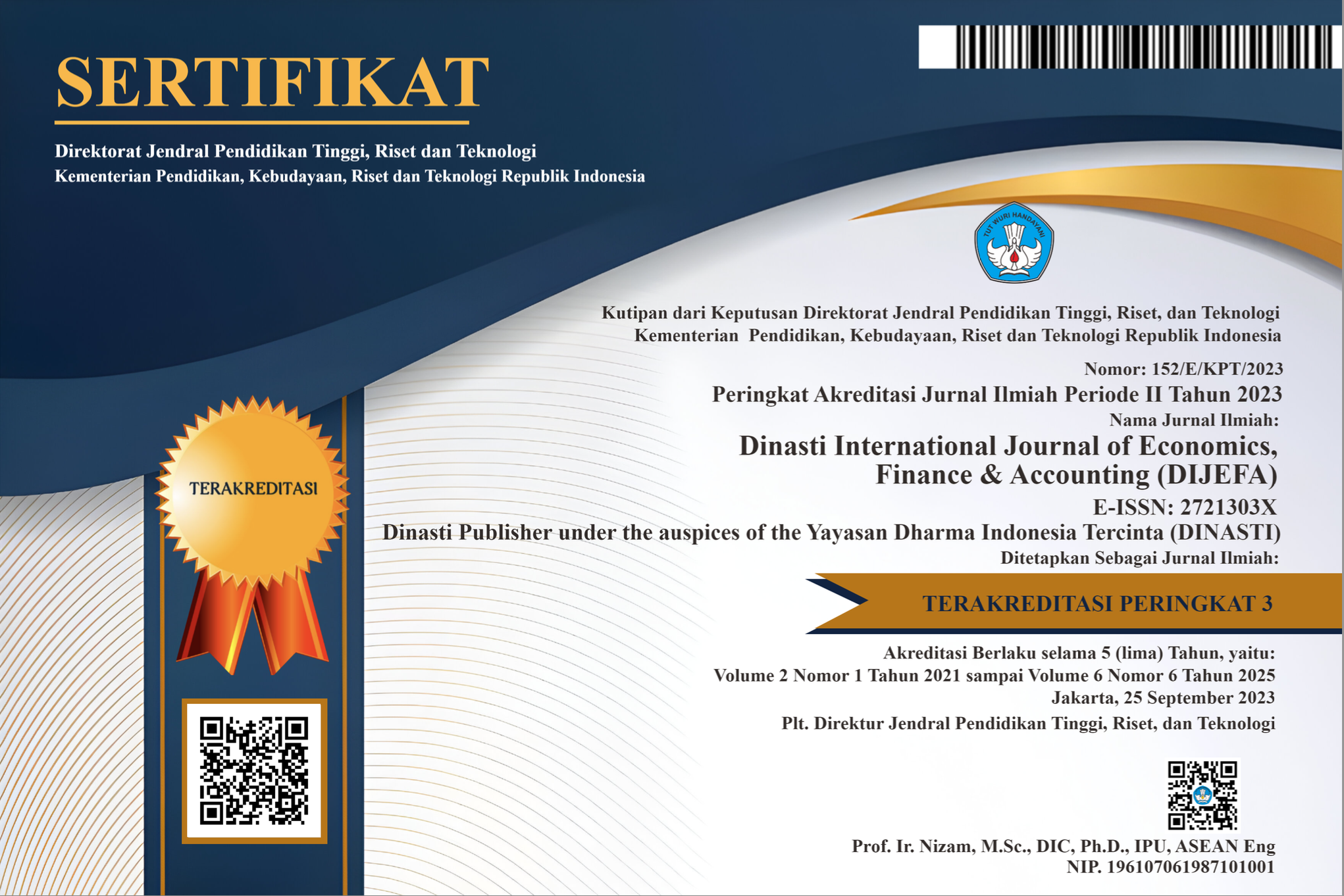The Impulse Buying Behavior: The Role of Financial Literacy, Perceived Usefulness, Perceived Ease of Use, And Security of E-Wallets (Case Study At Mercu Buana University Students)
DOI:
https://doi.org/10.38035/dijefa.v5i3.3054Keywords:
Financial Literacy, Perceived Usefulness, Perceived Ease Of Use, Security, Impulse Buying BehaviorAbstract
This study aims to analyze the effect of financial literacy, perceived usefulness, perceived ease of use, security of e-wallets on impulse buying behavior of Mercu Buana University students. This type of research is quantitative research, with data collection methods using questionnaires via Google Form link and distributed digitally to respondents. Theory Planned of Behavior (TPB) and Theory Acceptance Model (TAM) are used in this study. The population in this study was 1138 people. The sample selection method used was simple random sampling with a sample size of 296, and 307 respondents were found in this study. The object of this research is e-wallet user students who are currently pursuing undergraduate education at Universitas Mercu Buana Meruya, Faculty of Economics and Business, majoring in accounting, class of 2018-2021. The data analysis method used is the Partial Least Square Structural Equation Modeling (PLS-SEM) analysis technique using the SmartPLS version 3 software analysis tool. What differentiates this research from previous research is the object of research and the time this research was conducted, where the object of this research is Mercu Buana Meruya University students majoring in accounting class 2018-2021, with the research time conducted during the pandemic. Based on the results of the financial literacy, perceived ease of use, and security have a significant positive effect, while perceived usefulness has no effect on impulsive buying behavior. The limitations of this study are that the scope is not too broad, where researchers only focus on one location. And for further research it is better to add other variables that are outside this research.
References
Abdul-Halim, N. A., Vafaei-Zadeh, A., Hanifah, H., Teoh, A. P., & Nawaser, K. (2022). Understanding the Determinants of E-wallet Continuance Usage Intention in Malaysia. Quality and Quantity, 56(5), 3413–3439. https://doi.org/10.1007/s11135-021-01276-7
Aulia, S. (2020). Pola Perilaku Konsumen Digital Dalam Memanfaatkan Aplikasi Dompet Digital. Jurnal Komunikasi, 12(2), 311. https://doi.org/10.24912/jk.v12i2.9829
Belba?, A. G. (2022). Impacts of Covid-19 Pandemic on Consumer Behavior in Turkey: A Qualitative Study. Journal of Consumer Affairs, 56(1), 339–358. https://doi.org/10.1111/joca.12423
Budyastuti, T. (2020). Factors that Influence the Intensity of the Use of Digital Payment (Case Study in OVO Users). EPRA International Journal of Multidisciplinary Research (IJMR)-Peer Reviewed Journal, 6(6), 89–99. https://doi.org/10.36713/epra2013
Darmansyah. (2022). Siaran Pers: Indeks Literasi dan Inklusi Keuangan Masyarakat Meningkat. https://www.ojk.go.id/id/berita-dan-kegiatan/siaran-pers/Pages/Indeks-Literasi-dan-Inklusi-Keuangan-Masyarakat-Meningkat.aspx#:~:text=Hasil SNLIK tahun 2022 menunjukkan,inklusi keuangan 76%2C19 persen.
Darmawan, D., & Putra, A. R. (2022). Pengalaman Pengguna, Keamanan Transaksi, Kemudahan Penggunaan, Kenyamanan, Dan Pengaruhnya Terhadap Perilaku Pembelian Online Secara Impulsif. Relasi?: Jurnal Ekonomi, 18(1), 26–45. https://doi.org/10.31967/relasi.v18i1.523
Davis, F.D. (1986). A Technology Acceptance Model for Empirically Testing New End-User Information Systems: Theory and Results. MIT, 13(3).
Davis, Fred D. (1989). Perceived Usefulness, Perceived Ease of Use, and User Acceptance of Information Technology. MIS Quarterly, 13(3), 319–340. https://doi.org/10.5962/bhl.title.33621
Dhanty, W. R., Cahyati, A. V., & Alexandra, E. T. (2022). Analisis Pengaruh Kemudahan Paylater pada Aplikasi Shopee dan Promo Diskon Produk Terhadap Perilaku Pembelian Impulsif (Studi pada Pengguna Shopee di DKI Jakarta). Junral Manajemen Dan Bisnis Jayakarta, 04(01), 1–13.
Donthu, N., & Gustafsson, A. (2020). Effects of COVID-19 on business and research. Journal of Business Research, 117(June), 284–289. https://doi.org/10.1016/j.jbusres.2020.06.008
Fauziyah, W. N., & Julaeha, L. S. (2022). Pengaruh Desain Kemasan Terhadap Pembelian Impulsif yang Dimediasi Emosi Positif (Studi Kasus di Instagram @superjunior_elfindonesia)20220514. Jurnal Ilmiah Wahana Pendidikan, 8(7), 111–122. https://doi.org/10.5281/zenodo.6548380
Handoko, D. (2015). Keamanan Jaringan. CV Garuda Mas Sejahtera.
Hapsoro, B. B., & Kismiatun. (2022). The Effect of Perceived Ease of Use, Perceived Usefulness, and Perceived Security on E-Wallet Continuance Intention of Shopeepay Through E-Satisfaction Article Information. Management Analysis Journal. http://maj.unnes.ac.id
Iskandar, D., & Istaningsih. (2021). The effect of safety, easy and promotion on the behavior of food e-commerce use system in the COVID-19 pandemic time. International Journal of Management Studies and Social Science Research, 3(3), 352–371.
Iskandar, D., & Tanjung, J. (2023). The Effect of Knowledge, Security, Easy and Trust on the Behavior of Use of Financial Technology (Fintech) System (During the Covid-19 Pandemic). EPRA International Journal of Economics, Business and Management Studies, 10(1), 69–80. https://doi.org/10.36713/epra12204
Ismanto, H., Widiastuti, A., Muharam, H., Pangestuti, I. R. D., & Rofiq, F. (2019). Perbankan dan Literasi Keuangan (1st ed.). deepublish.
Ittaqullah, N., Madjid, R., & Suleman, N. R. (2020). The effects of mobile marketing, discount, and lifestyle on consumers’ impulse buying behavior in online marketplace. International Journal of Scientific and Technology Research, 9(3), 1569–1577.
Julianti, A. (2020). Kecemasan dan Pembelian Impulsif pada Saat Pandemi Covid-19. UG Jurnal, 14(12), 23–31.
Kusnandar, V. B. (2022). Transaksi Belanja Pakai Uang Elektronik Tembus Rp300 Triliun pada 2021. Databoks. https://databoks.katadata.co.id/datapublish/2022/09/28/transaksi-belanja-pakai-uang-elektronik-tembus-rp300-triliun-pada-2021
Lee, C.-H., & Chen, C.-W. (2021). Impulse Buying Behaviors in Live Streaming Commerce Based on the Stimulus-Organism-Response Framework. Information, 12(6), 1–17. https://doi.org/https://doi.org/10.3390/info12060241
Lidwina, A. (2021). Pola Belanja Online di Kalangan Anak Muda Berubah saat Pandemi. Databoks. https://databoks.katadata.co.id/datapublish/2021/06/03/pola-belanja-online-di-kalangan-anak-muda-berubah-saat-pandemi
Mayningsih, T., Nugroho, A., & Sihite, J. (2021). Analysis Regarding the Influence of Celebrity Endorsement , Advertising , Electronic Word of Mouth towards the Pur ... Journal of Business and Management (IOSR-JBM), 23(1), 7–16. https://doi.org/10.9790/487X-2301040716
Noviandi, F. S. (2022). Analisis Persepsi Konsumen Terhadap Keinginan Menggunakan E-Commerce dalam Bertransaksi Online. Fair Value?: Jurnal Ilmiah Akuntansi Dan Keuangan, 4(3), 1803–1812.
Nurjannah, N., Misbach, I., & Muin, R. (2021). The Maslahah of Muslim Consumer Behavior in Using E-Wallet in Makassar City. FITRAH: Jurnal Kajian Ilmu-Ilmu Keislaman, 7(1), 1–18. https://doi.org/10.24952/fitrah.v7i1.3331
Olivia, M., & Marchyta, N. K. (2022). The Influence of Perceived Ease of Use and Perceived Usefulness on E-Wallet Continuance Intention: Intervening Role of Customer Satisfaction. Jurnal Teknik Industri, 24(1), 13–22. https://doi.org/10.9744/jti.24.1.
Potrich, A. C. G., Vieira, K. M., & Kirch, G. (2017). How Well Do Women Do When it Comes to Financial Literacy? Proposition of an Indicator and Analysis of Gender Differences. Journal of Behavioral and Experimental Finance, 17, 28–41. https://doi.org/10.1016/j.jbef.2017.12.005
Pujiastuti, N., Reza, & Astuti, R. F. (2022). Pengaruh Literasi Ekonomi dan Lingkungan Sosial terhadap Perilaku Pembelian Impulsif pada Mahasiswa. Jurnal Riset Pendidikan Ekonomi, 7(1), 107–117. https://doi.org/10.21067/jrpe.v7i1.6710
Rahma, S. U. U., Bukhari, E., & Prasetyo, E. T. (2022). Pengaruh Literasi Keuangan, Pendapatan dan Gaya Hidup Terhadap Perilaku Konsumtif Belanja Online pada Masa Pandemi Covid-19. Jurnal Ilmiah Akuntansi Dan Manajemen (JIAM), 18(1), 49–56.
Rahmawati, Z., Nurfitri, T., & Widiastuti, E. (2022). Pengaruh Literasi Keuangan, Pengendalian Diri, dan Teman Sebaya Terhadap Perilaku Konsumtif (Studi Kasus Mahasiswa Pendidikan Ekonomi Universitas Jenderal Soedirman). Soedirman Economics Education Journal, 04(01), 16–28. https://doi.org/10.32424/seej.v4i1.5548
Rook, D. W. (1987). The Buying Impulse. Journal of Consumer Research, 14(2), 189. https://doi.org/10.1086/209105
Rossa, A., & Ashfath, F. (2022). Pengaruh Persepsi Kemudahan Penggunaan, Kepercayaan, Risiko dan Keamanan terhadap Impulse Buying Pengguna SPaylater (Shopee Paylater) di Jadetabek. Seminar Nasional Akuntansi Dan Manajemen PNJ, 3. http://prosiding-old.pnj.ac.id/index.php/snampnj/article/view/5518
Sandy, E., & Firdausy, C. M. (2021). Pengaruh Perceived Usefulness, Perceived Ease of Use dan Trust Terhadap Minat Konsumen dalam Penggunaan Ulang GO-PAY di Kota Jakarta. Jurnal Manajemen Bisnis Dan Kewirausahaan, 5(1), 22–27. https://doi.org/10.24912/jmbk.v5i1.10275
Sari, R. K., Utama, S. P., & Zairina, A. (2021). The Effect of Online Shopping and E-Wallet on Consumer Impulse Buying. Asia Pacific Management and Business Application, 9(3), 231–242. https://doi.org/10.21776/ub.apmba.2021.009.03.3
Sawlani, D. K. (2021). Keputusan Pembelian Online Kualitas Website, Keamanan, dan Kepercayaan (Pertama). Scopindo Media Pustaka.
Shin, Y. H., Im, J., Jung, S. E., & Severt, K. (2018). The theory of planned behavior and the norm activation model approach to consumer behavior regarding organic menus. International Journal of Hospitality Management, 69(March 2017), 21–29. https://doi.org/10.1016/j.ijhm.2017.10.011
Simorangkir, R. T. M. C. (2019). Implication of Internal Audit Quality, Individual Morality, Accounting Information Systems, Job Satisfaction, Asimetric Information and Good Governance on Accounting Fraudulent Tendency. International Journal of Advances in Social and Economics, 1(4). https://doi.org/10.33122/ijase.v1i4.118
Suratno, S., Rosmiati, R., & Siswono, E. (2021). Pengaruh Online Shop, Lingkungan Teman Sebaya dan Literasi Keuangan terhadap Pembelian Implusif Mahasiswa Jurusan PIPS FKIP Universitas Jambi. Jurnal Manajemen Pendidikan Dan Ilmu Sosial, 2(1), 61–75. https://dinastirev.org/JMPIS/article/view/414
Tamba, D. (2017). Aplikasi Theory of Planned Behavior untuk Memprediksi Perilaku mahasiswa Membeli Laptop Lenovo (Studi Kasus: Mahasiswa FE - Unika Santo Thomas SU). Jurnal Manajemen Dan Bisnis, 17(2), 115–141. https://doi.org/https://doi.org/10.54367/jmb.v17i2.411
Downloads
Published
How to Cite
Issue
Section
License
Copyright (c) 2024 Rona Tumiur Mauli Carolin Simorangkir, Pratiwi Nila Sari

This work is licensed under a Creative Commons Attribution 4.0 International License.
Authors who publish their manuscripts in this journal agree to the following conditions:
- The copyright on each article belongs to the author(s).
- The author acknowledges that the Dinasti International Journal of Economics, Finance & Accounting (DIJEFA) has the right to be the first to publish with a Creative Commons Attribution 4.0 International license (Attribution 4.0 International (CC BY 4.0).
- Authors can submit articles separately, arrange for the non-exclusive distribution of manuscripts that have been published in this journal into other versions (e.g., sent to the author's institutional repository, publication into books, etc.), by acknowledging that the manuscript has been published for the first time in the Dinasti International Journal of Economics, Finance & Accounting (DIJEFA).


























































